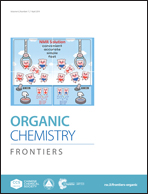Mechanical generation of isocyanate by mechanically induced retro [2 + 2] cycloaddition of a 1,2-diazetidinone mechanophore†
Abstract
The encapsulation of guests in supramolecular capsules has long been used to trap reactive intermediates and enhance or reduce the kinetic stability of reactants, and alter the products of chemical reactions that occur within the capsule interior. In recent years, multiple studies have shown that variations of normal reactivity patterns can be induced by trapping reactants under tension, for example along a backbone of an overextended polymer chain, in a manner that is fundamentally very different from, but reminiscent of, encapsulation. Here, we describe the formation of a mechanochemically generated isocyante via a mechanical retro [2 + 2] cycloaddition of a 1,2-diazetidinone (DAO) mechanophore. A single DAO mechanophore is incorporated into the chain center of a poly(methyl acrylate) (PMA) backbone via single electron transfer-living radical polymerization (SET-LRP). Mechanical activation of the DAO via ultrasonic sonication leads to the formation of isocyanate and imine products, as supported by trapping experiments using 9-(methylaminomethyl)anthracene labelling and 1H NMR spectroscopy. Further, we examine the relative mechanical susceptibility of chain-centered DAO mechanophores through a variety of methods, and evaluate the advantage and disadvantage of each.
![Graphical abstract: Mechanical generation of isocyanate by mechanically induced retro [2 + 2] cycloaddition of a 1,2-diazetidinone mechanophore](/en/Image/Get?imageInfo.ImageType=GA&imageInfo.ImageIdentifier.ManuscriptID=C9QO00262F&imageInfo.ImageIdentifier.Year=2019)
- This article is part of the themed collection: In celebration of Julius Rebek’s 75th Birthday


 Please wait while we load your content...
Please wait while we load your content...